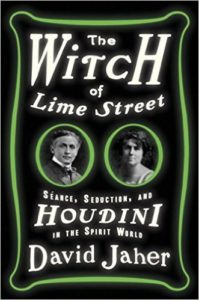The Witch of Lime Street: Séance, Seduction, and Houdini in the Spirit World
By: David Jaher
In a captivating narration of a face-off between the accomplished escape-artist Houdini and the charming hostess of 10 Lime Street, Jaher draws us into the unknown. Houdini has stunned audiences everywhere with his daring feats, but he desperately wants to communicate with someone he loved and lost – his mother. With a slow build, Jaher sets the scenario and introduces the cast. In an unfulfilling search to contact his mother, Houdini exposes flimflam artists everywhere – he has a very definite view on what is acceptable or not, and taking advantage of those grieving loved ones falls into the “unacceptable” category. When Houdini befriends a huge proponent of the Spiritualist movement but remains unconvinced of the mediumship displayed being genuine, it isn’t long before a scientific contest to prove authentic mediums exist is established.
Not a Typical Historical Read
Despite personal opinions on mediumship and séances, there were events in The Witch of Lime Street that had me as a reader baffled. As Jaher’s novel is depicting actual historical events, it would have been easy for the novel to come across as dry and boring, however that was not the case. Once the stage was set the novel drew me in and I was eager to discover what happened next. Houdini was a very complex, realistic character. Despite his pride and arrogance, he also came across as deeply layered – passionate about his cause and desperately determined to prevent “mediums” with nothing more than street tricks (something Houdini himself was very familiar with) from fooling the bereaved.
The “witch” known as Margery was also a very complex, well-written character. Despite her background, Margery is described by all who meet her as cultured and of a far better stock than a typical run-of-the-mill medium. Despite the rigorous testing Margery is put through (and tolerates with good humor) in order to determine whether or not her mediumship is genuine, Margery offers very little resistance and continues to go above and beyond as an excellent hostess. As Jaher introduces more information about Margery, as a reader you start to realize the difficult position Margery is in. She is a character that induces a sympathetic response the more you understand her.
More Information Would Be Nice
It would have been nice to hear more about involvement from Bess, Houdini’s wife (she is mostly present at the beginning and end of the novel, and not in any major way) however, with the sources Jaher worked with for this novel it is understandable that she may not have been mentioned much (and this story does not revolve around her). I also would have very much liked to have read whether any verdict on the Crandon’s involvement with the “lost boys” was determined – and if not the Crandon’s, where were those children? Jaher briefly introduces the mystery in the chapter entitled “Lost Boys” (pg. 345), but doesn’t tell us of any solution.
Typically, historical novels are not in my zone of interest, but The Witch of Lime Street was a fascinating read and I’m glad to have read it. Jaher primarily came across as pro-Spiritualist, but he still presented the story with countless sources as evidence to back him and without noticeably skewing the facts either way. For those who wish to review Jaher’s sources, he lists them in the back of the novel.
Disclaimer: I received this book for free from Blogging for Books in exchange for my honest review. All opinions are my own.

Christian, wife, “hybrid” mama, I run the site All Behind A Smile to help others like me.



Leave a Reply